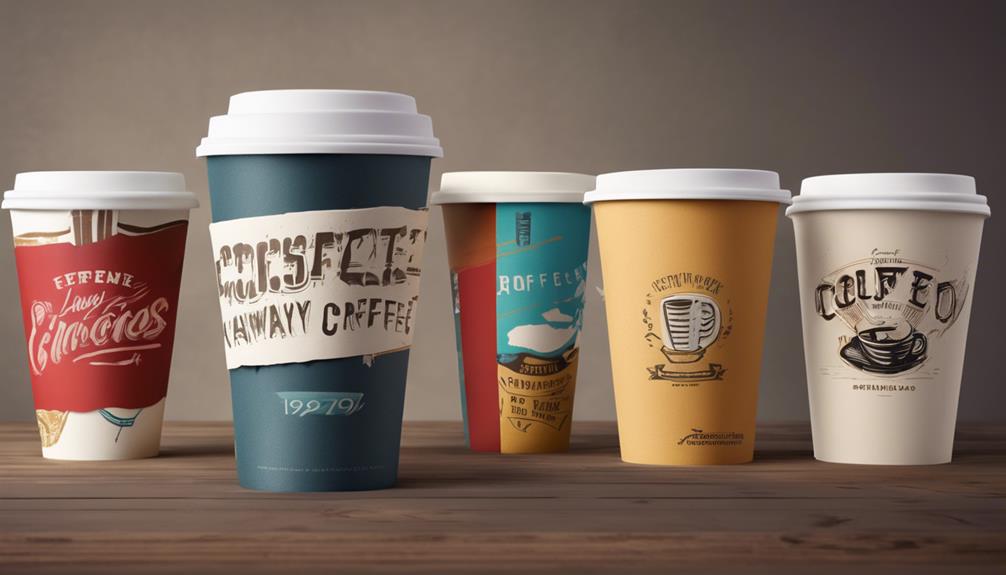When you grab your morning coffee to kickstart your day, have you ever stopped to ponder the journey of that takeaway cup from your favorite cafe to your hands? The tale behind these ubiquitous vessels holds intriguing insights into our modern-day coffee culture and the environmental implications of our daily caffeine fix. So, what lies beneath the lid of your trusty coffee cup?
The History of Takeaway Coffee Cups

Takeaway coffee cups have evolved considerably over the years, with their origins dating back to the early 20th century. As coffee culture expanded and urban lifestyles became busier, the need for a convenient way to enjoy coffee on the go grew. This demand led to the design evolution of takeaway coffee cups to meet the needs of modern consumers.
In the early days, takeaway coffee cups were simple vessels made of paper or styrofoam, primarily focused on functionality rather than aesthetics. However, with the rise of specialty coffee shops and the increasing importance of branding, the design of these cups began to change. From quirky patterns to customizable options, takeaway coffee cups started to reflect the unique identities of the cafes serving them.
Today, takeaway coffee cups aren't just containers for hot beverages; they're also statements of style and identity. The evolution of these cups continues to be influenced by the ever-changing coffee culture and the fast-paced nature of urban life.
Environmental Impact of Disposable Cups
Explore
Disposable cups made a significant environmental impact due to their widespread use and improper disposal methods. The carbon footprint of manufacturing these cups, especially the plastic ones, is substantial. Plastic pollution is a major concern as many disposable cups end up in landfills or oceans, taking hundreds of years to decompose.
To combat this issue, biodegradable options have been introduced as a more eco-friendly alternative. These cups are made from materials that break down more easily, reducing the long-term environmental impact.
Paper cup alternatives are also gaining popularity as they're biodegradable and can be recycled. Paper cups have a lower carbon footprint compared to their plastic counterparts, making them a more sustainable choice. By opting for paper cups instead of plastic ones, you can help reduce plastic pollution and lessen the environmental impact of disposable cups.
Next, we'll explore recycling and composting solutions to further address the environmental challenges posed by takeaway coffee cups.
Recycling and Composting Solutions

Consider implementing proper recycling and composting practices to reduce the environmental impact of coffee cup waste. Opt for compostable options and utilize recycling programs to make sure that disposable cups are disposed of in an eco-friendly manner.
Look for biodegradable materials when selecting disposable cups, as they break down naturally, reducing the burden on landfills and the environment. Recycling programs play an important role in diverting coffee cups from ending up in landfills, where they can take years to decompose.
By actively participating in recycling initiatives, you contribute to a more sustainable approach to waste management. When choosing eco-friendly solutions, prioritize compostable options that can be broken down into natural elements. These cups can be composted alongside organic waste, reducing the overall environmental impact.
Supporting businesses that offer compostable or biodegradable cups encourages the adoption of sustainable practices in the food and beverage industry. Remember, small changes in your daily habits, such as opting for compostable cups and participating in recycling programs, can collectively make a significant difference in reducing the environmental footprint of takeaway coffee cups.
Reusable Alternatives for Sustainability
When aiming for sustainability, prioritize using reusable coffee cups to reduce waste and environmental impact.
Travel mugs are a fantastic eco-friendly option that allows you to enjoy your favorite brew on the go without contributing to single-use cup waste. These mugs are durable, easy to clean, and come in a variety of designs to suit your style. Consider investing in a travel mug with silicone sleeves, providing a comfortable grip while insulating your drink.
Another sustainable choice is bamboo cups, which are biodegradable and renewable. Bamboo is a fast-growing plant that requires minimal resources to thrive, making it an excellent eco-conscious alternative to disposable cups. Bamboo cups are lightweight, sturdy, and can be reused countless times, making them a great addition to your daily coffee routine.
Tips for Reducing Single-Use Cup Waste

Opt for reusable coffee cups as a vital solution to minimize single-use cup waste. By choosing reusable options, you actively contribute to waste reduction and make eco-friendly choices that benefit the environment. Consumer behavior plays an essential role in reducing single-use cup waste. Simple actions like bringing your reusable cup to the coffee shop or investing in a durable travel mug can have a substantial impact on the amount of waste generated from disposable cups.
When making your daily coffee run, consider the long-term benefits of using a reusable cup. Many coffee shops offer discounts to customers who bring their own cups, encouraging eco-conscious practices. Developing a habit of carrying a reusable cup not only reduces waste but also saves you money in the long run.
Additionally, look for stylish and functional reusable cups that suit your lifestyle. With a wide range of options available, you can find a cup that fits your preferences and makes your coffee routine more sustainable. By making small changes in your daily habits, you can play a part in reducing single-use cup waste and promoting a greener future.
Conclusion
Next time you grab a takeaway coffee, consider the impact of your choice. Opt for reusable cups or make sure the disposable one ends up in the recycling bin.
Every small change can make a big difference in reducing single-use cup waste and protecting our environment.
Let's all do our part to enjoy our coffee responsibly and sustainably.




